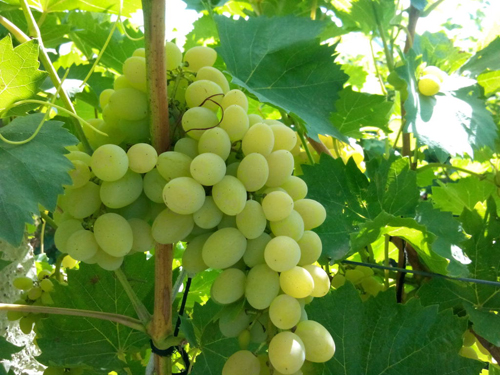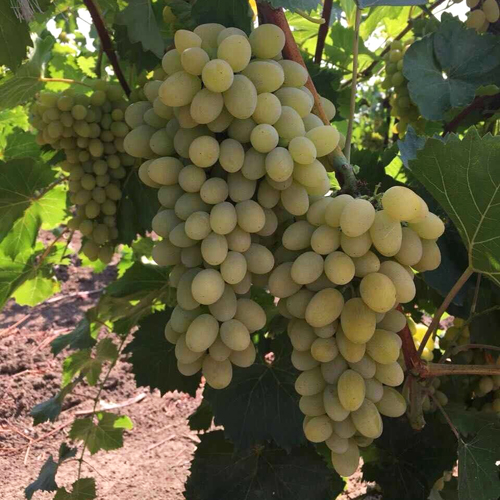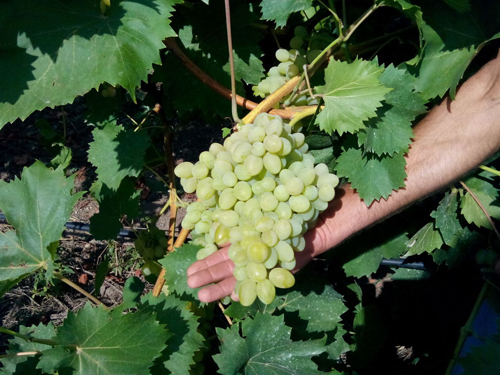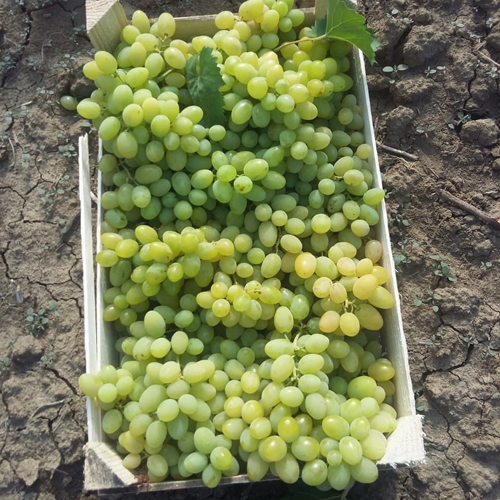Pleven grape variety
Bulgaria has long been famous for its viticulture industry. The small Balkan country is one of the ten countries in the world in terms of the total area of vineyards. At the same time, a significant part of these plantings is occupied not by technical varieties, but by canteens - intended for fresh grape consumption and processing by the canning industry.

There are several research institutions in Bulgaria, which, since the country's independence, have been actively engaged in the development of local varieties of grapes, many of which glorify local scientists far beyond the borders of the country. A characteristic feature of these studies can be called their emphasis on high quality, with a secondary attitude to economic characteristics. In this regard, until recently, mainly purebred representatives of the noble European-Asian grapes Vitis vinifera were used for crosses, and only recently have attempts begun to add practicality to local varieties by mixing them with genes of resistant interspecific hybrids. Because of this, most of the Bulgarian breeding developments of the last century turn out to be as capricious as the ancient European varieties. One can hardly think that epidemics of mildew, oidium, phylloxera have passed by Bulgaria, but loyalty to traditions here, apparently, is not an empty phrase.
One of these controversial varieties is Pleven, bred at the Institute of Grape and Wine from the city of the same name. It was born in 1961, and seven years later passed the state variety test and was admitted to industrial cultivation. The authors of the new hybrid form at that time were the scientists of the Institute K. Stoev, Ya. Ivanov, Z. Zankov and V. Valchev. The maternal form for crossing was the well-known variety Italy, and the paternal one was the local grape Amber, a descendant of the Queen of the Vineyards and Caraburnu.
Thanks to his famous ancestors, Pleven can be credited with excellent aesthetic and gastronomic properties, but resistance to diseases and pests is clearly not his strong point. It also does not shine with frost resistance, which is why even at home in some regions it is grown in a covering culture, not to mention more northern latitudes. The yield is quite moderate. Over the past years, our hero has not found tremendous popularity, but in Bulgaria it is common in all viticultural regions. In the post-Soviet space, it grows in very limited quantities, mainly in the south. In our country, his descendant is much more popular - Pleven Stable (Augustine), one of the few Bulgarian varieties created by using interspecific hybrids to increase the resistance of grapes to unfavorable environmental factors.

Agrobiological characteristics
Plants are highly vigorous. Leaves grow dark green, rounded, medium to large, five-lobed with a strong degree of dissection, smooth surface and no pubescence on the back. The upper lateral incisions are deep, closed with a narrow elliptical lumen and a sharp bottom, the lower incisions are of medium depth, open, slit-like with parallel sides. The petiole notch is deep, open, arched, wide at the base. The denticles along the edge of the leaf blade are high, triangular, with a narrow base, straight edges and sharp tops. The flowers are bisexual, in any weather they are perfectly pollinated by their own pollen. In addition, according to winegrowers, Pleven is a good pollinator for varieties with a functionally female type of flower. Ripening of annual shoots is early and complete. The autumn color of the leaves is yellow.
Bunches of a medium-sized variety - 18-20 cm long and 16-18 cm wide, conical or winged, of moderate density. The average weight of a ripe brush is 250-320 grams.The comb is rather long, graceful, light green. The berries are large and very large, elongated-cylindrical, 23-25 mm long and up to 18 mm in diameter. The color of the grapes is yellow-green, often tanned on the sunlit side, the average weight is 5-6 grams. The surface of the berries is covered with a thick light prune bloom. The pulp is juicy, fleshy-crunchy with a pleasant harmonious neutral taste, without specific notes in the aftertaste and aroma. The juice squeezed from grapes is rather sweet due to the low titratable acidity (5-5.5 g / l), although its sugar content is also very moderate (15-16 g / 100 ml). The skin of the berries may seem thick, but due to its fragility and tenderness, it chews without problems. There are seeds, but they do not have an excessively negative effect on the taste of the crop. There are only one or two of them in each berry. Tasting evaluations always show a very decent result. According to gourmets, Pleven resembles its famous ancestor - the ancient Turkish variety Karaburnu, which has exceptional fruit quality.

The crop is excellent for fresh consumption and canning. From the point of view of external data, our Bulgarian hero is somewhat inferior in attractiveness to larger-fruited varieties of grapes. However, due to the nobility of taste, not every competitor is able to outshine him. It produces juices and compotes, excellent in lightness, as well as beautiful preserves and jams. The collected bunches perfectly tolerate long-distance transportation, and due to the significant thickness of the skin of the berries, they are also well stored, which is not always typical for early ripening grapes. If you carefully lay out Pleven's brushes in a cool room with low positive temperatures and low relative humidity in one layer on a bed of straw or sawdust, or hang them here on a wire, you can achieve the preservation of the crop for three or more months.
The growing season from the moment the buds awaken to the onset of removable maturity in the variety is 115-125 days. Due to such a relatively short period, at home it ripens in early August, and in our country, in the Lower Don region, at the end of the first - beginning of the second decade of the same month. To achieve the required conditions, Pleven needs about 2450-2550 ° C of the sum of active temperatures. This theoretically makes it possible to expand the geography of its cultivation to the latitude of Ryazan, Kaluga and Kaliningrad, however, one must take into account the weak frost resistance of plants and the need, therefore, in the northern regions to very carefully cover the vine for the winter.
The yield of the variety is quite high for its time, but it is significantly inferior to modern productive varieties. In Bulgaria, with the Guyot formation widespread there, up to 5 kilograms of grapes are obtained from a bush, and up to 100 centners of production from a hectare at a planting density of 2000 plants per unit of area. In amateur plantings with good care, our growers achieve somewhat better results, but they rarely get more than 10 kg per bush. The relatively low productivity also has a positive side - the plants rarely suffer from overload, shoots and clusters always ripen on time, and the winegrower does not need to carry out exhausting and careful regulation of the crop load.

After the grapes are ripe, they can continue to remain on the vine for a long time without the risk of damage or deterioration of the presentation due to the thick skin of the berries. The grapes are not susceptible to cracking even in unfavorable seasons with a large amount of rainfall, as well as with changes in soil moisture. They are not attacked by wasps due to the inability to bite through the skin.And even in relation to gray rot, unlike other fungal diseases, Pleven demonstrates a certain resistance.
Agrotechnical features
The variety, as already mentioned, is quite capricious, which is quite logical given its pedigree. Obtaining a bountiful harvest of good quality will require significant efforts, especially in our climatic conditions, which in the vast majority of regions are incomparably tougher than Bulgarian ones. For planting, Pleven prefers warm, loose, fertile, water and air permeable soils. Grapes do not tolerate cold swampy lowlands, northern slopes, places with a high level of groundwater. At the same time, it is picky about the level of soil moisture, does not tolerate severe droughts. It grows very well on irrigated lands, but is sensitive to high levels of salts, which can sometimes cause developmental problems here.
The variety is susceptible to phylloxera, which is why in the zones of its distribution it requires inoculation on phylloxera-resistant rootstocks. Has a good affinity with such forms as Berlandieri x Riparia Kober 5BB and Riparia x Rupestris 101-14. In a self-rooted culture, it can be cultivated only where there is no harmful soil pest. The planting scheme with a vertical garter of one-year growth is recommended with a row spacing of 2.25-2.5 meters, and a distance between bushes in a row of 1.5-1.75 meters. The grape feeding area should be at least 4-4.5 sq. meters.
Pleven has a rather weak frost resistance. Already at a temperature of -20 ... -21 ° C, the aboveground part of the bush receives significant damage, after which it recovers for a long time, and with a further decrease in the thermometer column, the complete death of the plant is possible. Thus, its cultivation in a non-sheltered culture is possible only in the Crimea and on the Black Sea coast of the North Caucasus. In other regions, the vines need to be warmed for the winter, and the more northern the region of cultivation is, the more powerful and solid the shelter should be. In central Russia, for a satisfactory wintering of bushes of this variety, it will be necessary to organize two-layer shelters with the use of organic insulation - straw, peat, leaves or reeds, and the subsequent waterproofing of the entire structure with materials that do not allow moisture to pass through. Only those buds that are kept in dry insulation throughout the winter remain viable. If this condition is not met, there is a high likelihood of damping out the eyes on the grape vine.
For the convenience of removing the wintering parts of the plant from the trellis in the fall and to minimize their damage, special covering forms of the bush are used. In Bulgaria, ground-level Guyot is used for this, and in domestic viticulture, an inclined cordon, and especially a multi-arm fan, is widespread. They are easy to form, easy to use, and fully meet the needs of the culture. In the third year, the Pleven bush will be fully formed and ready for full fruiting. In rare cases, if it is possible not to cover the plants due to the mild climate, the variety is grown on a high stem, ideally with a free location of one-year growth. In this case, the grapes are able to show their most excellent qualities, primarily aesthetic and taste, as well as increase productivity due to the growth of the size of the brushes. However, this will also require some increase in the row spacing, as a payback for the overall, but productive formation.
The bushes are loaded in the spring with 35−45 eyes with a slight shortening of the fruit arrows - up to 8−10 buds. In the future, as usual, a fragment of sterile and weak young shoots is carried out, but the tiresome thinning of inflorescences can be almost completely abandoned.It will not be difficult for strong vines to "stretch" even two brushes per shoot, due to the not very outstanding large-fruited variety. The optimal load can be considered the presence of 25-30 bunches on a bush of grapes.
The productivity of Pleven can also be increased by regular abundant irrigation with simultaneous application of mineral fertilizers. During the growing season, up to 5-6 irrigations are carried out, of which the most important are: early spring watering with ammonium nitrate, as well as before flowering and during the period of active growth of berries with the addition of phosphorus-potassium fertilizers to the water. Autumn watering is also very useful, with the help of which plants are stored with moisture. Thanks to this, their winter hardiness somewhat grows, and the moist soil in the cold season freezes to a shallower depth.
The weak resistance of grapes to pathogens of fungal diseases requires the implementation of a set of measures for its chemical protection against pathogens. The number of treatments per season can reach 8-9, which, of course, does not contribute to obtaining an environmentally friendly harvest. However, in order to minimize the negative effect of such frequent spraying with fungicides, they should be carried out strictly according to the instructions for each specific preparation, following the recommendations for their consumption per unit area, and always observing the waiting time between the last treatment and harvest.
In general, in our conditions, Pleven can be considered a very exotic guest, because in the range of even the Bulgarian selection there are much more convenient and less whimsical varieties of grapes. Apparently, therefore, he never received wide distribution in the post-Soviet space, even among amateurs.








